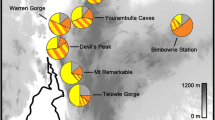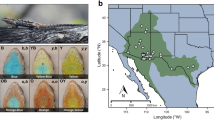Abstract
The study of polymorphic organisms in which sexual selection strongly drives the maintenance of the polymorphism often ignores the environmental context. However, natural selection is also crucial, often interacting with sexual selection. While most evidence suggests that sexual selection underlies the maintenance of the colour polymorphism shown by the common wall lizard, Podarcis muralis, involving up to five sympatric morphs (white -W-, yellow -Y-, orange -O-, white-orange -WO- and yellow-orange -YO), recent results using realised niche models suggest morph distribution at a geographical scale is constrained by climate. The Y and YO morphs occupy a narrow space within the niche of the other morphs, and local frequencies of W, WO and O morphs are environmentally dependent, with O and WO showing higher local frequencies in the most humid habitats. We hypothesised that morphs may behaviourally compensate for these differences at a microhabitat scale. Here, we tested this hypothesis collecting field microhabitat data from representative natural populations. Results highlighted that O lizards are partially segregated in microhabitat relative to the other morphs, tending to occupy more humid (vegetated, close to water) sites, and suggesting a physiological constraint. In contrast, the other morphs do not differ in microhabitat use, suggesting that the ecological restriction of Y and YO morphs derives from an indirect relationship between climate and population parameters (sex ratio, density) crucial for social selection, eventually involving alternative behavioural strategies.
Significance statement
The maintenance of different colour phenotypes (morphs) in a single population occurs in complex evolutionary scenarios where several selective forces interact. Common wall lizards may be white, orange, yellow, white-orange or yellow-orange ventrally. This polymorphism is most likely driven by sexual selection, but climate probably constraints the environmental distribution of morphs, driving local morph diversity. Here, we explore if geographical differences in morph distribution result in microhabitat segregation. Our results show that orange lizards appear more frequently in humid habitats than the other morphs, suggesting a direct relationship between ecophysiology and habitat use. Although yellow and yellow-orange morphs present a narrow distribution at a geographical scale, they do not differ from the white and white-orange morphs in microhabitat, suggesting that their restricted distribution is indirectly caused by some source of environmental dependence on social selection instead of a direct physiological constraint.



Similar content being viewed by others
References
Ábalos J, Pérez i de Lanuza G, Carazo P, Font E (2016) The role of male coloration in the outcome of staged contests in the European common wall lizard (Podarcis muralis). Behaviour 153:607–631
Andrade P, Pinho C, Afonso S et al (2017) Pleiotropy of pigmentation genes explains phenotypic differences among sympatric color morphs in a lizard. 16th international meeting of the European Society of Evolutionary Biology (ESEB 2017), Groningen (abstract)
Benjamini Y, Hochberg Y (1995) Controlling the false discovery rate: a practical and powerful approach to multiple testing. J R Stat Soc B 57:289–300
Blondel J, Aronson J, Bodiou JY, Boeuf G (2010) The Mediterranean region: biological diversity in space and time. Oxford University Press, New York
Calsbeek B, Hasselquist D, Clobert J (2010) Multivariate phenotypes and the potential for alternative phenotypic optima in wall lizard (Podarcis muralis) ventral colour morphs. J Evol Biol 23:1138–1147
Donald PF (2007) Adult sex ratios in wild bird populations. Ibis 149:671–692
Farallo VR, Forstner MRJ (2012) Predation and the maintenance of color polymorphism in a habitat specialist squamate. PLoS One 7:e30316
Ferreira CC, Santos X, Carretero MA (2016) Does ecophysiology mediate reptile responses to fire regimes? Evidence from Iberian lizards. PeerJ 4:e2107
Friedman D, Magnani J, Paranjpe D, Sinervo B (2017) Evolutionary games, climate and the generation of diversity. PLoS One 12:e0184052
Galeotti P, Sacchi R, Pellitteri-Rosa D, Bellati A, Cocca W, Gentilli A, Scali S, Fasola M (2013) Colour polymorphism and alternative breeding strategies: effects of parent’s colour morph on fitness traits in the common wall lizard. Evol Biol 40:385–394
Gomes V, Carretero MA, Kaliontzopoulou A (2016) The relevance of morphology for habitat use and locomotion in two species of wall lizards. Acta Oecol 70:87–95
Gosden TP, Stoks R, Svensson EI (2011) Range limits, large-scale biogeographic variation, and localized evolutionary dynamics in a polymorphic damselfly. Biol J Linn Soc 102:775–785
Green KK, Svensson EI, Bergsten J, Härdling R, Hansson B (2014) The interplay between local ecology, divergent selection, and genetic drift in population divergence of a sexually antagonistic female trait. Evolution 68:1934–1946
Jobson JD (1992) Applied multivariate data analysis. Volume II: categorical and multivariate methods. Springer, New York
Karlsson GK, Kovalev A, Svensson EI, Gorb SN (2013) Male clasping ability, female polymorphism and sexual conflict: fine-scale elytral morphology as a sexually antagonistic adaptation in female diving beetles. J R Soc Interface 10:20130409
Le Galliard JF, Fitze PS, Ferrière R, Clobert J (2005) Sex ratio bias, male aggression, and population collapse in lizards. P Natl Acad Sci USA 102:18231–18236
Lebart L, Morineau A, Warwick KW (1984) Multivariate description statistical analysis, correspondence analysis and related techniques for large matrices. Dunod, Paris
McKinnon JS, Pierotti ME (2010) Colour polymorphism and correlated characters: genetic mechanisms and evolution. Mol Ecol 19:5101–5125
McLean CA, Stuart-Fox D, Moussalli A (2015) Environment, but not genetic divergence, influences geographic variation in colour morph frequencies in a lizard. BMC Evol Biol 15:156
Merilaita S, Jormalainem V (1997) Evolution of sex differences in microhabitat choice and colour polymorphism in Idotea baltica. Anim Behav 54:769–778
Miller CW, Svensson EI (2014) Sexual selection in complex environments. Annu Rev Entomol 59:427–445
Pérez i de Lanuza G, Font E (2015) Differences in conspicuousness between alternative color morphs in a polychromatic lizard. Behav Ecol 26:1432–1446
Pérez i de Lanuza G, Font E, Carazo P (2013) Colour assortative mating in a colour polymorphic lacertid lizard. Behav Ecol 24:273–279
Pérez i de Lanuza G, Carazo P, Font E (2014) Colours of quality: structural (but not pigment) coloration informs about male quality in a polychromatic lizard. Anim Behav 90:73–81
Pérez i de Lanuza G, Carretero MA, Font E (2016a) Thermal-dependence of signalling: do polymorphic wall lizards compensate for morph-specific differences in conspicuousness? Behav Ecol Sociobiol 70:1151–1159
Pérez i de Lanuza G, Font E, Carretero MA (2016b) Colour assortative pairing in a colour polymorphic lizard is independent of population morph diversity. Sci Nat 103:1–7
Pérez i de Lanuza G, Carretero MA, Font E (2017) Intensity of male-male competition predicts morph diversity in a colour polymorphic lizard. Evolution 71:1832–1840
Romero-Díaz C, Breedveld MC, Fitze PS (2017) Climate effects on growth, body condition, and survival depend on the genetic characteristics of the population. Am Nat 190:649–662
Roulin A (2004) The evolution, maintenance and adaptive function of genetic colour polymorphism in birds. Biol Rev 79:815–848
Sacchi R, Scali S, Pupin F, Gentilli A, Galeotti P, Fasola M (2007) Microgeographic variation of color morph frequency and biometry of common wall lizards. J Zool 273:389–396
Santos X, Azor JS, Cortés S, Rodríguez E, Larios J, Pleguezuelos JM (2017) Ecological significance of dorsal polymorphism in a Batesian mimic snake. Curr Zool published online, https://doi.org/10.1093/cz/zox058
Sinervo B, Lively CM (1996) The rock-paper-scissors game and the evolution of alternative male reproductive strategies. Nature 380:240–243
Sinervo B, Bleay C, Adamopoulou C (2001) Social causes of correlational selection and the resolution of a heritable throat color polymorphism in a lizard. Evolution 55:2040–2052
Svensson EI (2017) Back to basics: using colour polymorphisms to study evolutionary processes. Mol Ecol 26:2204–2211
Svensson EI, Waller JT (2013) Ecology and sexual selection: evolution of wing pigmentation in calopterygid damselflies in relation to latitude, sexual dimorphism, and speciation. Am Nat 182:E174–E195
Wapstra E, Uller T, Sinn DL, Olsson M, Maruzek K, Joss J, Shine R (2009) Climate effects on offspring sex ratio in a viviparous lizard. J Anim Ecol 78:84–90
Wellenreuther N, Svensson EI, Hansson B (2014) Sexual selection and genetic color polymorphisms in animals. Mol Ecol 23:5398–5414
Acknowledgments
We are grateful to D. Klomp for comments on an earlier version of this manuscript. We also thank the editor and two anonymous reviewers for their valuable comments.
Funding
GPL was supported by post-doctoral grant (SFRH/BPD/94582/2013) from FCT under the Programa Operacional Potencial Humano – Quadro de Referência Estratégico Nacional funded by the European Social Fund and Portuguese Ministério da Educação e Ciência. MAC is supported by project NORTE-01-0145-FEDER-000007. The study was supported by FEDER through the COMPETE program (ref. 008929) and Portuguese national funds through the FCT (Fundação para a Ciência e a Tecnologia, Portugal) project PTDC/BIA-BEC/101256/2008, the FCT project 30288 02/SAICT/2017 (Projetos de Desenvolvimento e Implementação de Infraestruturas de Investigação, RNIE - Programa Operacional Regional do Norte - Portugal 2020), and a grant (CGL2011-23751) from the Spanish Ministerio de Ciencia e Innovación.
Author information
Authors and Affiliations
Corresponding author
Ethics declarations
Conflict of interest
The authors declare that they have no conflict of interest.
Ethical approval
Binocular observations allowed minimising lizard disturbance (at worst, lizards avoided the observer by moving away). No lizards were captured or manipulated during the observations. The habitat was not altered in any way. This research complied with the ASAB/ABS Guidelines for the Use of Animals in Research. Permits for working in our study area were provided by the Préfecture des Pyrénées Orientales (Arrêté no. 2016-2-09).
Additional information
Communicated by S. J. Downes
Rights and permissions
About this article
Cite this article
Pérez i de Lanuza, G., Carretero, M.A. Partial divergence in microhabitat use suggests environmental-dependent selection on a colour polymorphic lizard. Behav Ecol Sociobiol 72, 138 (2018). https://doi.org/10.1007/s00265-018-2550-2
Received:
Revised:
Accepted:
Published:
DOI: https://doi.org/10.1007/s00265-018-2550-2




